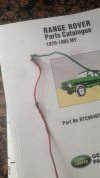Jim_P
Active Member
- Posts
- 51
- Location
- ATHENS GREECE
Here we go again !
So, after replacing the old alternator (55amp) with a new factory spec unit (65amp) as well as the voltage stabilizer on the instrument cluster i went for a drive. It was the evening so i switched the headlights on.
After about 5 minutes, smoke started coming out from under the dash. Stopped and dealt with it. Found what wire melted and its the red wire from the headlight switch. Its got the good ol red, brown, blue combo.
I know that these are prone to corrosion and then a sudden short circuit scenario which is what i believe happened here but i would like some more feedback.
The red wire which is the sidelights one burned from its starting point at the switch all the way back to the rear LH (as viewed from the rear) taillight. So the part that goes inside the car under the headliner and ends up at the taillight. The front sidelights are all fine with no melted red wires.
Now could that be the rear taillight itself that is creating the issue ? The grounds on all of them were clean and sound. Or is the switch the most probable cause ?
The harness has indeed been modified by the Fire Department the Rangie was assigned to and the red wire has one of these dreaded blue plastic clip on connectors out of which another wire goes to what i believe must have been a siren combo unit.
I am going to replace the main harness anyway along with the intermediate one and possibly the engine one too as these were part of my plan but in the future. Just wanted to know what you guys think about the possible sources of my issues. It can't be the new alternator i think. It would have had the bulbs go boom first and its own wires hot, right ?
Let me know. Any feedback is more than welcome.
PS
A lights fuse mod will definitely be something of interest on the new harness.
So, after replacing the old alternator (55amp) with a new factory spec unit (65amp) as well as the voltage stabilizer on the instrument cluster i went for a drive. It was the evening so i switched the headlights on.
After about 5 minutes, smoke started coming out from under the dash. Stopped and dealt with it. Found what wire melted and its the red wire from the headlight switch. Its got the good ol red, brown, blue combo.
I know that these are prone to corrosion and then a sudden short circuit scenario which is what i believe happened here but i would like some more feedback.
The red wire which is the sidelights one burned from its starting point at the switch all the way back to the rear LH (as viewed from the rear) taillight. So the part that goes inside the car under the headliner and ends up at the taillight. The front sidelights are all fine with no melted red wires.
Now could that be the rear taillight itself that is creating the issue ? The grounds on all of them were clean and sound. Or is the switch the most probable cause ?
The harness has indeed been modified by the Fire Department the Rangie was assigned to and the red wire has one of these dreaded blue plastic clip on connectors out of which another wire goes to what i believe must have been a siren combo unit.
I am going to replace the main harness anyway along with the intermediate one and possibly the engine one too as these were part of my plan but in the future. Just wanted to know what you guys think about the possible sources of my issues. It can't be the new alternator i think. It would have had the bulbs go boom first and its own wires hot, right ?
Let me know. Any feedback is more than welcome.
PS
A lights fuse mod will definitely be something of interest on the new harness.

